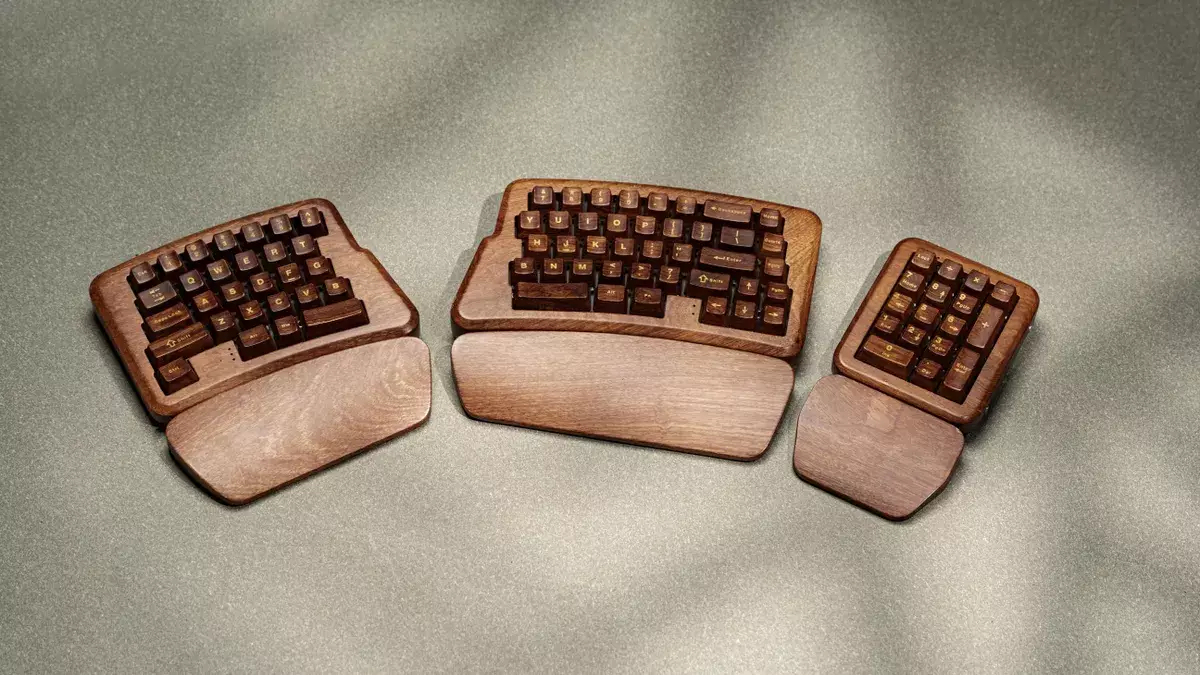Navigating the expansive terrain of computer hardware can often inspire both excitement and apprehension. For enthusiasts, the quest for innovative devices is akin to treasure hunting; each discovery holds the potential for enhanced performance and aesthetic pleasure. However, not all innovations are met with universal acclaim, particularly those that challenge conventional design norms. One such example is the Epomaker x Feker Alice 60, a split ergonomic keyboard that raises eyebrows and invites skepticism. This article delves into the unique offerings of this wooden keyboard, its potential benefits, and discusses the polarizing nature of its design.
Split ergonomic keyboards have carved out a niche in the marketplace, offering a refreshing take on conventional keyboard layouts. The appeal of the split design lies in its purported benefits for wrist and hand posture, aiming to mitigate the strain often associated with long hours of typing. When examining the Alice 60, the keyboard consists of two separate halves, allowing users to adjust their hand positioning to a more natural alignment. This purported ergonomic advantage could resonate with those who have experienced discomfort from traditional keyboards.
However, not everyone may find solace in this design approach. While some users, like the colleague who expressed desire for the Alice 60 despite its unique aesthetics, revel in the split format, others may struggle to adapt. The bifurcated layout can feel foreign, and for new users, the learning curve may be a deterrent rather than a benefit. This dichotomy highlights a critical challenge in hardware design: creating products that cater to both existing ergonomic enthusiasts and newcomers who may be hesitant to embrace non-traditional styles.
Sustainability and aesthetics play pivotal roles in modern consumer choices, leading many manufacturers to explore natural materials like wood for their products. Epomaker boldly embraces this trend by constructing the Alice 60 entirely from wood, a decision that offers both a distinct look and certain functional perks. Proponents of wooden keyboards argue that the natural material dampens sound effectively, producing a muted audio profile that can enhance the typing experience, particularly in quiet environments.
The sensory experience of typing on wood is undeniably unique. For some, the soft thud of wooden keycaps can evoke a charming, rustic feel, transforming an everyday task into a more pleasurable endeavor. However, skepticism abounds. The notion of wooden keycaps can evoke discomfort in many, who may be concerned about the cleanliness and durability of such materials compared to traditional plastic alternatives. It raises essential questions: Are the aesthetic and acoustic benefits enough to outweigh concerns about maintenance and longevity?
At a staggering price of $549, the Alice 60 places itself firmly in the luxury section of the keyboard market. This cost raises eyebrows for a product primarily made of wood, especially when competitors offer high-functionality models—like the Asus ROG Azoth Extreme—with advanced features such as OLED screens and extremely high polling rates for less.
This price point demands scrutiny not only of the materials used but also of the overall value a user receives. For a significant investment, customers might expect cutting-edge features, but the Alice 60’s primary selling point revolves around its design. This can create a perception of inflated costs for what may appear to be a niche product tailored for a specific audience. Additionally, potential buyers must weigh the investment against the availability of more functional keyboards that excel in performance, ultimately leading to a critical conversation about consumer expectations and value.
One of the most telling aspects of the Alice 60 is its polarizing nature within the keyboard enthusiast community. Personal preferences in keyboard aesthetics and ergonomics can deeply influence individual experiences. While certain users are drawn to the natural appeal of wood, others might experience an “ick” factor that prevents them from considering its practicality seriously.
This diversity of opinion exemplifies a broader theme in the technology sector: innovative designs may captivate some while alienating others. As manufacturers pursue various avenues of creativity to set their products apart, they must navigate complex consumer landscapes filled with subjective preferences. Finding balance is essential, as designers aim to intrigue both conventional users and adventurous enthusiasts.
The Epomaker x Feker Alice 60 demonstrates that innovation in technology can provoke thoughtful reflection and spirited debate. Its unique wooden design and ergonomic concept challenge traditional notions of what a keyboard should be. While the allure of aesthetic and acoustic benefits is evident, the price tag and mixed responses suggest significant challenges ahead. In the end, the Alice 60 invites discussion—not merely about its form and function, but about the future of ergonomic design in a world increasingly inspired by sustainability and creativity. Whether this wooden keyboard finds a home in the hearts of keyboard enthusiasts remains to be seen, but it undeniably stimulates important conversations in tech design history.

